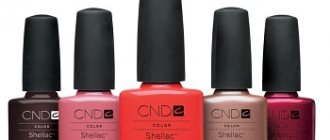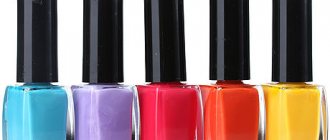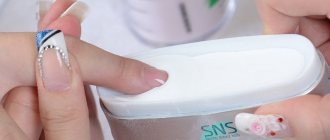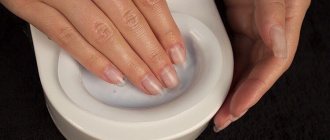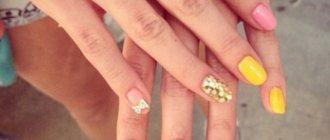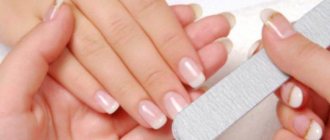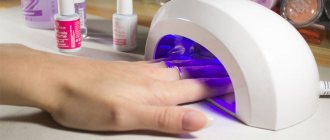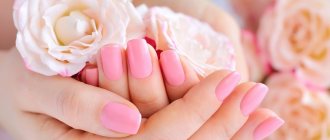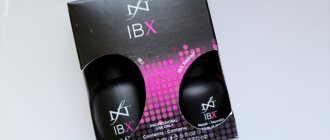What does gel polish consist of?
There are hundreds of brands offering nail coatings on the shelves of online and offline stores. In most cases, the composition of these products is identical and includes the same components.
The most common ingredients in gel polish include:
- Monomers . Hidden on the label under the combinations of Hydroxypropyl Acrylate and Hydroxyethyl Methacrylate. Monomers are used to harden the coating when exposed to ultraviolet rays;
- Photoinitiator - Hydroxycyclohexyl phenyl ketone. Absorbs ultraviolet rays and starts the polymerization process. Depending on the manufacturer, the amount of photoinitiator varies, which affects the speed of solidification;
- Pigment is a substance that provides a color coating. The composition is marked with an abbreviation, for example CI 8965;
- Solvents . Used to facilitate polymerization that occurs when entering into a chemical bond with monomers;
- Fragrances . To give the product an unobtrusive aroma of fruits or flowers.
The listed components are the basis of the gel polish, which allows it to create a dense coating on the nails with an increased wear time. In addition to the basic components, the composition also contains auxiliary ones - they are the ones that pose a health hazard.
What components of gel polishes and other coatings should be avoided:
- Formaldehyde, Formaldehyde. The most dangerous component that has been discussed from the first day of its addition to the varnish. Formaldehyde is a preservative that promotes long-term storage of the product and prevents the growth of bacteria. The component is allowed for use in nail polishes, but it is prohibited for contact with skin . Formaldehyde often causes allergies to gel polish coating. Manufacturers often hide the presence of formaldehyde in the composition and use non-standard names on the label - Aldehyd mravenc, Bfv, Methanal. Despite the danger, formaldehyde is actively used by manufacturers. Only in the USA a restriction has been introduced allowing the use of no more than 11% of it in the composition;
- Formaldehyde resin. May lead to skin inflammation and dermatitis.
- Toluene, Toluene is a substance from the group of solvents. Also referred to on the label as methylbenzene, methylbenzene, methane. Toluene is a toxic component, the vapors of which in high concentrations cause disorientation. Naturally, varnishes use a minimal amount of the substance, but even this is enough to cause irritation or an allergic reaction. Prohibited for use in all countries within the European Union ;
- Dibutyl Phthalate, DBP - a component that protects the coating from cracking. It allows the gel polish to plasticize. Dibutyl phthalate has a negative effect on women's health, hormonal levels and provokes problems with reproductive function. In Europe, the component is prohibited for use in cosmetics ;
- Methylisothiazolinone is a preservative that increases the shelf life of the product. Even in small quantities, the component disrupts the functioning of the central nervous system and also negatively affects brain function;
- Camphor, Camphor - used to add gloss. It is a relatively safe component, but with prolonged use it causes allergies. Inhalation of camphor provokes headache and nausea;
- Xylene, Xylene , is another component from the group of solvents that often causes allergic reactions. In addition, xylene may cause side effects such as dizziness, nausea and vomiting;
- Triphenyl phosphate is a plasticizer. It tends to be absorbed through the cuticle and accumulate in the body. Affects the hormonal system. Research by American scientists has proven that triphenyl phosphate has a negative effect on the endocrine system;
- Parabens are sulfate preservatives that mimic estrogen production. Studies have shown that exposure to parabens can trigger the development of breast tumors;
- tosylamide . May cause severe allergic reactions, destruction of liver cells;
- Acetone , Acetone - when inhaled, it can cause inflammation and sore throat.
Is gel polish harmful to health?
Gel polish may be harmful to health in some cases:
- When coating is done for obvious problems with nails. For example, they are thinned, pain is felt, there is a gray coating on the surface, or the color in some places has turned green or brown. This may indicate the development of a fungal disease or burn, which requires treatment, not design.
- When the coating is poorly dried, that is, it is polymerized on top, but closer to the nail it remains wet. This is another favorable factor for an infection called Pseudomonas - Pseudomonas. It makes the natural nail green.
- When there is an allergy. It may not appear immediately, but as the unwanted substance accumulates in the body. That is, not even from the first manicure, but after correction with the same means. The fingers begin to itch and hurt, the skin turns red and becomes wet.
- When there are detachments of the material, and the girl does not remove it for weeks. The narrow space between the nail and the coating is a favorable environment for bacteria. Dirt and sweat get in there and are difficult to clean out. The result is a change in the color and structure of the plate, indicating a degenerative process or infection.
- When the cuticle is not cleaned thoroughly enough, and varnish has flowed into it. This is also the cause of the inflammatory process, and then suppuration. At first a small wound forms, then it grows, and the pain intensifies. As a result, the nail may begin to grow already changed - lumpy and peeling.
- When the coating is cut off indoors without an exhaust hood and without a mask on the face. Small particles enter the respiratory tract and can cause asthma. Those who often have colds and are prone to allergies are especially at risk.
The most harmful products from the gel polish coating system
Acid primer
It is the primer that helps the coating stay on the nails for a long time, but methacrylic acid spoils the nail plate. As an option, use an acid-free primer, but you shouldn’t believe that there really is no acid in its composition - there is, but another and more gentle one.
A couple of tips to minimize primer damage:
- Experiment. If the coating on the nails lasts more than two weeks without a primer, there is no need to further injure the nail;
- When you cannot do without the product, apply it not to the entire nail, but only to the tip - this will allow the coating to adhere to the stress zone and increase the wear time.
Primers should be used with extreme caution as they provide a fantastic adhesion between the coating and the nail.
It seems to the craftsmen that they bought a quality product, although in fact, an unscrupulous manufacturer added more acid to it. This product cannot be used on an ongoing basis.
Products with a dispersion layer
The sticky layer is the residual stickiness after polymerization of the coating in gel polish. It is the dispersion layer that causes intoxication and allergies, so the skin must be protected, and the work of the master must be careful and fast. After polymerization, the layer is removed with a special means.
Gel polish removers
The main component of coating removers is acetone, which dries out the skin and destroys the structure of the nail.
Acetone vapors irritate the mucous membranes and, with constant inhalation, cause problems in the central nervous system. Because of such a destructive effect, nail artists refuse to soak the coating in favor of cutting it off with a milling cutter.
Lung diseases among manicurists and other occupational diseases, prevention
Does gel polish ruin your nails?
Gel polish spoils your nails if:
- Perform hygienic manicure too carefully. A well-processed cuticle looks attractive, but deep penetration of a cutter or pusher under the skin can cause injury to the matrix. Nails will begin to grow wavy or with permanent cracks. And this is a favorable environment for infections to enter and inflammation to begin. A fungal disease, panaritium, may occur.
- Re-wear the coating, that is, do not go for correction 3 weeks after the manicure. In this case, the load on the regrown edge of the nail increases. As a result, blood circulation in this area is disrupted and the matrix weakens. And onycholysis may occur. And it is especially undesirable to over-stretch for a long length, since the plates can break “into meat”.
- Apply thick layers of polymerizing agents each time. This requires prolonged drying in a lamp, as a result of which the tissue overheats. This is manifested by a burning sensation. And then the nails may become lumpy or, on the contrary, thin out and begin to peel off from the bed.
- Use unsuitable materials. For each type of nail, you need to choose the right base and top coat. Soft ones need a product like strong or other types of strengthening. Applying a rubber base will increase their mobility, that is, increase the risk of breakage and delamination. If the nails are quite strong and hard, they need a softer base. A product marked strong will tighten the plates, which can cause them to crack and break.
- Use low quality products. As a rule, they contain the harmful components mentioned earlier. They dry out the nails and corrode the top layer. As a result, the plates become lumpy, change color, fade, flake and break.
What harm do polishes and gel polishes cause?
- The first and most common disease is the appearance of allergies. Clients experience irritation and inflammation of the nail bed as well as the skin around the nail. Masters face sneezing, lacrimation and allergic rhinitis;
- With frequent use of toxic coating products, the nail plate turns yellow, thins and becomes brittle. This is most often caused by using an acidic primer on an ongoing basis;
- The consequences are greatest among manicurists. Constant inhalation of vapors provokes the development of allergies and lung diseases;
- Studies have shown that the constant use of nail polishes with a toxic composition affects all organs of the human body, causes kidney failure and even provokes the development of cancer.
How to choose a safe gel polish
You can determine the safety and quality of gel polish at first glance at the composition, but for this you will have to:
- Go to the official website of the manufacturer;
- Find information about the composition;
- Make sure that the composition contains hydroxyethyl methacrylate. The component is sometimes replaced by the abbreviation HEMA. It allows for good adhesion of the coating to the nail, while ensuring easy removal;
- Also look for the Free mark on the label - it indicates that the varnish does not contain some toxic substances.
If one of these words is found in the composition, you have a professional and safe product. Please note that the presence of these substances does not guarantee that the varnish will wear well and will not crack or chip. Finding the ideal product will only be possible through trial and error.
What are cosmetics made of?
The best harmless gel nail polishes
Gel nail polishes, which have already proven themselves to be as harmless as possible, are:
- Kodi is rubber-based and contains natural oils;
- IBD, which is easy to apply and remove, does not contain harmful components;
- Ingarden with natural resins and silicones in its composition;
- Irisk, which contains natural oils, has no allergens;
- OPI, known for its abundance of natural ingredients;
- IQ Beauty with calcium;
- Luxio is solvent- and formaldehyde-free, hypoallergenic;
- Grattol, which do not contain acrylic and methacrylic acids and other ingredients that provoke intolerance.
But even when using these funds, individual reactions must be taken into account. It is also important to buy original gel polishes, and not replicas or fakes.
Security categories Free
Manufacturers of nail polishes indicate on the label the safety category “Free” plus a number from 3 to 12. Such polishes are “free” from a number of toxic chemicals that can cause serious illnesses.
3-Free
3-Free varnishes do not contain formaldehyde, toluene or plasticizers.
There are several varnishes of the 3-free category on the Russian market:
- Divage;
- Orly;
- Patrisa Nail;
- Rimmel;
- Maybelline.
5-Free
In addition to formaldehyde, toluene and plasticizers, 5-Free products also do not use formaldehyde resin or camphor.
Brands designated 5-Free:
- Aurelia;
- Chanel;
- Zoya;
- Inglot.
7-Free
7-Free varnishes are free of xylene, formaldehyde and its resins, camphor, triphenyl phosphate, toluene and dibutyl phtholate.
Lucky 7-free:
- ANNY;
- CND Shellac;
- Jessica;
- LVX.
8-Free
8-Free does not contain the 7 components listed above and does not contain parabens.
There are not many products on the Russian market without 8 hazardous substances:
- By Terry;
- Smith & Cult;
- Tenoverten.
10-Free
10-Free polishes are considered vegan. They do not contain all of the above harmful substances, as well as components of animal origin - guanine, keratin and carmine, and are not tested on animals.
No toxic substances are used in production. Vegan polishes:
- ZAO;
- Butter LONDON;
- Color Club.
You can also find 11, 12 and even 13-free on sale, but this is more of a marketing ploy. Manufacturers do exclude some common ingredients, such as gluten, which is inherently safe. Gluten can cause negative reactions only in a narrow part of the population - those who are lactose intolerant.
How often can you do gel polish, can you do it all the time?
Gel polish can be done frequently, that is, every 2-3 weeks if the nails are growing rapidly and there are no problems with them. It’s worse if they have grown a lot, but the coating remains the same. This not only looks unsightly, but also harms your nails. The polymer bonds of the coating begin to disintegrate and release harmful substances, which penetrate through the plate.
In addition, worn-out coating is more difficult to remove. The remover will have to be kept on the nails longer, and when filing, there is a greater chance of damage to the plate. After all, the adhesion of the material may strengthen over time.
Doing gel polish all the time is harmful even with healthy and very strong nails. There are chances of missing the beginning of problems with them due to exposure to chemicals and lamps. After all, during correction, only the color coating is often removed, leaving the base. And you can’t evaluate the appearance of your nails.
And if the material is completely removed, this is also difficult, since the surfaces of the plates are treated with a buffer and wiped with a degreaser and primer before coating. And to understand whether everything is in order, you need to wait until at least part of the nails, untouched by tools and liquids, grow back. That is, take a break for at least 3-5 weeks. It’s better to extend it for 3.5 months, because it is during this period that the nails are completely renewed.
In addition, with constant and long-term wearing of gel polish, the plates become thinner, as they are buffed, dried with a dehydrator and degreaser, and the surface is loosened with a primer. To avoid critical thinning, it is better not to apply long-term coating for several weeks a year.
Safe gel polishes
There are relatively safe products not only in the luxury segment, but also in the economy segment. Let's figure out which brands to pay attention to first.
CND
The American brand has earned the attention of craftsmen thanks to the release of a product called Shellac.
- The properties of the product are no different from gel polish, but it allows you not to use a primer - this makes it even safer in comparison with conventional gel coating.
- Shellac from CND complies with the 7-Free standard.
- The brand has a wide color palette and also has an MSDS safety data sheet, confirming compliance with international quality standards.
- Shellac contains no formaldehyde or toluene.
The shellac coating system is safer than the average gel polish. But, at the same time, if you set a goal, you can choose a gel polish that is safer than shellac. For example, from 8- or 10-Free funds.
All about shellac - properties and comparison with other coatings, how to do a manicure
Opi
Another American brand that has become a favorite among nail artists. Opi is a leader in the nail services industry and cares about the quality of its products. The palette here is no smaller than that of CND, but the coating ends up being somewhat thinner. The composition excludes components harmful to clients and artists, and also contains amino acids that are beneficial for nails.
Kodi
The American brand became famous thanks to its rubber formula, which provides a plastic, durable coating. Only safe components are used for production, and the base is a rubber polymer of natural origin. Natural rubber is resistant to alcohol, water and acetone.
Bluesky
The budget brand offers more than a hundred shades and is also famous for its safe composition. Apart from the Pigments and components necessary for polymerization, nothing else is indicated in the composition. Many professionals who are satisfied with the price-quality ratio work with the manufacturer’s gel polishes.
However, there have been cases where customers have reported an allergic reaction to Bluesky. There is no documentary evidence of its allergenicity, so the gel polish continues to be listed as safe.
Beautix
Beautix is a professional brand of high quality manicure products. The safest components are used for production, which minimize all risks associated with applying gel polish. The main advantage of the company’s gel polishes is that they are practically odorless.
The palette includes more than 200 shades.
CNI
Another professional brand with a lot of positive reviews. Many masters switched to CNI after CND and were satisfied, and this speaks of the European quality of gel polishes. The manufacturer does not classify its products as “free”.
Nano Professional
The gel polishes of this company are gaining more and more popularity every year. This is because in the Nano Professional laboratory daily experiments are carried out to improve the composition and increase its safety. There are no dangerous components in the composition, and animal products are also excluded.
BANDI
Bandi's products come from South Korea, which has existed since 2008.
In Russia, the brand is not so widespread, while in Korea the company occupies 60% of the market. The thing is that the manufacturer has developed an innovative product for Korea - 7-free gel polish. You won't find in the composition:
- Toluene;
- Formaldehyde and its derivatives;
- Camphor;
- Dibutyl phthalate;
- Tosilami;
- Xylene.
Naturally, as expected for environmentally friendly companies, BANDI gel polishes are not tested on animals.
Nailor
Nailor is a new product on the Russian market and is only gaining popularity, although the first mentions in magazines and stores were back in 2021. The brand is distinguished by its careful selection of gel polish shades - at the moment there are about 75-80 of them.
Each tone is given the name of a great artist - there is Repin, Serebryakova and Aivazovsky. Due to the fact that Nailor gel polishes have not yet become as widespread as CND or, say, Beautix, there is no information about their quality in terms of wear yet. There is no fault with the composition - it belongs to the 9-free category.
The following are not used in production:
- Formaldehyde and its resins;
- Toluene;
- Xylene;
- Dibutyl phthalate;
- Camphor;
- Tosilamide;
- Triphenylphosphate;
- Parabens.
The composition of the varnish complies with European Union quality standards.
The technology of nail makeup with soft varnishes is a more environmentally friendly option for nail design:
What is nail makeup and how is it done?
Option
Almost all Option products are hypoallergenic, with the exception of some gels. Organic pigments are used in production, and all hazardous components are excluded. According to the information on the packaging of Organic gel polishes, they consist of:
- Urethane oligomer;
- Photoinitiator;
- Hydroxyethyl methacrylate;
- Pigment.
The “Options” palette is quite modest - a little more than 50 shades, including basic, basic colors. The reason for the limited choice is the difficulty of working with organic pigments - they are capricious and do not always lend themselves to experimentation. The brand's products have eco-certificates confirming their safety and environmental friendliness. We spoke separately about our use of the Organic line of the Option brand.
Lianail
The Russian brand Lianail offers gel polishes of the 9-Free category, free of formaldehyde and its derivatives, xylene, camphor, dibutyl phthalate, toluene, and parabens. The latest development of the brand - the Factor collection, which, in addition to its safe composition, has excellent strength and amazing self-leveling - is suitable even for beginners.
The range of shades is huge - from barely noticeable nudes to rich reds, blues, yellows. In addition, there are bases, tops, design products, and cuticle oils.
Who should not have a fashionable manicure with gel polish and why?
Not all women know that fashionable gel polish manicure is contraindicated for some of them. In this article we will tell you who and why experts do not recommend using shellac and gel coating on nails.
The dangers of gel polish
Sometimes manicurists use low-quality gel polish, which ruins the nails. It is possible that your nails have become accustomed to constantly wearing polish and have become brittle and yellowed.
Gel polish is no different from shellac except that it is patented by the manufacturer. Therefore, if your master assures you that it is impossible to ruin your nails with shellac, this is not true.
When and who is not recommended to wear gel polish on nails?
Fungus on nails
If you have been diagnosed with a fungus on your nails and have just had treatment, then forget about a manicure with gel polish for a while, as it can harm the treated nails.
It’s better to get by with clear varnish or special medicinal coatings with added vitamins for a while. There are different varnishes:
- strengthening, it will create a film on the nail plate, onto which you can then apply regular colored varnish; - varnish against yellow nails, it contains many vitamins.
After treating nail fungus, doctors advise not to do a design with gel polish for a while so that the nails are restored and strengthened, but they do not prohibit doing a regular manicure. A European unedged manicure is suitable.
Ingrown nail
If it happens that you have a problem with an ingrown nail and it had to be removed, then you may have to extend the nail. But fortunately, ingrown toenails do not happen so often on the hands. But if it does happen, then for some time you cannot do any manicure (or pedicure).
Only 2-3 weeks later, after the seam has healed, you can do a manicure, not forgetting to cover your nails with medicinal varnish.
Peeling nails
Your nails are peeling, but you want to see a gel polish manicure on your nails? Don’t waste your money and time - gel polish won’t last long on peeling nails. The coating will come off the original nail within a few days after application. First, you should find out the reason why your nails are peeling and cure them from the inside. After all, peeling nails can be a sign of a lack of vitamins and minerals in the body.
Nails that are too thin and brittle
If your nails are too thin and they often break to the point of “meat,” then filling microcracks on the nail plate with acrylic compound and covering your nails with colored gel polish will only worsen the situation. Instead of a fashionable manicure with gel polish, ask your nail technician for advice on a medicinal coating. A good specialist will definitely recommend an effective nail strengthening product that he has in stock.
Nails with white spots
White spots on nails are the first signal of problems in the human body. Therefore, the first thing you need to do is remove the gel polish and go to the doctor, get tested and find out the problem of stains. If it is a lack of vitamins and minerals, you will be prescribed vitamin complexes and a special healing transparent varnish that cannot be removed from the nail. The coating will remain on the nail plate all the time until the diseased nail grows back. Until the nails are completely renewed, this varnish will nourish them with useful elements.
Cracked nails
Cracks in nails can appear under both gel polish and regular polish. Such cracks go far into the nail, so gel polish cannot be applied to such a nail. You will have to work on strengthening your nails and give up shellac until the cracks disappear.
Nails cannot wear gel polish for long
This occurs in those women who wear manicures with this coating for a long time without a break. Without proper rest from gel polish or other coatings, your nails simply begin to get tired. An easy way to restore them is to give them a rest from any coating.
How to protect yourself from allergies and get rid of symptoms
Not the most natural composition, the presence of harmful and allergenic components - this causes itching and inflammation on the client’s hands. But if you follow simple tips, you can reduce the risk of developing allergies to a minimum and get rid of the symptoms of the disease that have already appeared.
- If an allergy has already manifested itself, do not cover your nails with gel polish or other means until complete recovery;
- Choose varnishes from the “Free” category. For example, 3-Free does not contain formaldehyde, which most often causes an allergic reaction;
- Avoid accompanying medications as much as possible, especially if they are not urgently needed. For example, if the coating adheres well even without a primer, you should not further injure the nail plate and body with it.
Allergy to manicure: how to determine the cause, remove symptoms and how to replace gel polish
Contraindications for gel polish
Even expensive and high-quality gel polish has contraindications for use:
- allergies to it or other products used in manicure;
- dystrophic diseases of the nail plates (onycholysis, etc.);
- fungus of nails and skin of hands;
- damage to the plates and periungual space;
- burns in this area;
- hand skin infections;
- treatment with hormonal drugs (taking oral contraceptives to prevent pregnancy does not count);
- chemotherapy or the recovery period after it.
You may not want to wear gel polish if you have a lot of moles on your hands and have a hereditary predisposition to skin cancer. It is better to discuss this with your doctor. The procedure should be postponed if the temperature rises and on critical days.
Some tips for craftsmen
Masters are several times more susceptible to side effects from using toxic products than their clients. To make work safe, and also not to encounter the development of diseases, it is recommended to follow several tips:
- Use only high-quality products - this will affect the quality of your manicure and protect you from allergies, headaches and other side effects;
- Wear gloves. Yes, it will be uncomfortable at first, but by protecting your hands, you will save your skin from contact with harmful substances of the composition;
- Use a mask to reduce the amount of fumes and dust you inhale.
Personal protective equipment for a manicurist - all types of harmful effects in the salon and how to protect yourself

